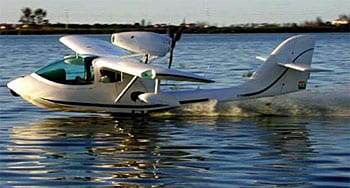Landing on water with your wheels down is a confirmed aviation no-no. Land planes that try it often get flipped over and upside down, when escaping the cabin becomes a real concern. Every seaplane pilot I know has a mantra he or she repeats, “I’m landing on water so the wheels must be up.”
Most simply don’t want to make this mistake. You can land a seaplane or floatplane on land with the wheels up. The penalty is not as great (and you’ll certainly stop fast). However, you violate the wheels-into-water rule at your peril.
Some airplanes, like the new CTLS on amphib floats, FPNA’s Capetown, or SeaRey have a light-alert system to help you, while some manufacturers offer an audio alarm. Others use mirrors or have other warning systems.
So why would someone land a SeaMax in water with the wheels down? Deliberately? And for the camera? To test the results — and a YouTube video shows what a non-event this is. (You also might enjoy hearing the camera audio continue working even when it gets dunked.)
While you still don’t want to repeat this if you can avoid it, the video proves that, done with experience, the maneuver may not upset the SeaMax. The amphibious LSA benefits from sitting low in the water, so the rotating action of gear hanging down well below the fuselage is less of a problem.

As the trusty, always-working camera shows, the pilot raised the gear before takeoff. Trying to launch gear down would be a futile effort from all the in-water drag it would impart.
For more on Sport Pilot and Light Sport Aircraft: ByDanJohnson.com

Here is what we teach our students at our high performance/complex seaplane training school in Orlando:
THE “GUMP” acronym in an amphib takes on new meaning, as most amphibs will be upside down in seconds if landed gear down on water and many many folks have needlessly died/drown because of it….so the usual GUMP checklist is modified for amphibs…G stands for gear, check it. U stands for undercarriage, check the gear again. M stands for “make sure the gear is correct” and finally, P stands for “positively check the gear, you fool”….I actually prefer this checklist to any warning that both Wipaire and Baumman Floats have….their gear warning system is usually airspeed triggered and can at times be very distracting. Anything distracting can at times be dangerous! In addition to religously advocating use of this special GUMP checklist, we advocate that in an amphib, after each takeoff, RAISE THE GEAR, regardless! One can land an amphib gear up on land and cause relatively little damage except perhaps to one’s ego, but landing one gear down on water in most cases helps people drown, quickly.
for 30 years I owned and flew a turbo 210 extensively from east to west across this great country. I’m sure the wheels up advantage paid for itsef many times over. With so much water available for an emergency landing I considered the retractable gear an added safety feature for a smooth touchdown. It’s surprising the added sense of comfort this provides. Cirrus owners probably should consider.
Check out Wipaire’s gear advisory system if you own a amphibious aircraft without a gear position warning system.
It’s a simple and very effective system indicating your gear position with either 4 green or 4 blue lights. Installation of this system should benefit your insurance premiums (reduction) for hull insurance.